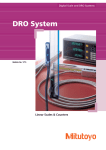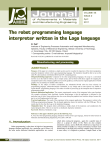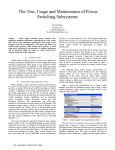Download A LOW-COST SWITCH FOR AC
Transcript
A LOW-COST SWITCH FOR AC-DC TRANSFER M. Kampik Silesian Technical University ul. Akademicka 10, 44-100 Gliwice, Poland Abstract: A low-cost switch for ac-dc transfer is presented in this paper. The switch performs fast switching of the input of the thermal voltage converter (TVC) between AC and DC calibrator outputs. It can be controlled through the GPIB bus, manually and through the serial RS-232 interface. Both 4-wire and 2-wire connection between the TVC and the calibrators is possible. The switch provides very fast switching. The dead time of the switch is less than 5 ms. The switch is well protected against relay and power failures. Keywords: transfer switch, AC-DC transfer, thermal voltage converter 1 INTRODUCTION Each thermal AC-DC voltage transfer measurement system requires a device which performs fast switching of the input of the thermal voltage converter (TVC) between AC and DC calibrator outputs. There are no commercially available switches on the market, which could be directly implemented in the AC-DC transfer. An exception is the switch designed at OFMET [1]. Most laboratories use switches of their own design and construction [2]. This diversity helps to detect eventual systematic errors which can be caused by the switch. The switch presented in the paper is another approach. 2 REQUIREMENTS The switches used in the AC-DC transfer can be generally divided into rotary- and relay type. Usually the most expensive parts of a switch are the rotary switches or relays. From the economical point of view it is important to fit these parts to the measurement needs. Well designed switch, however, should allow an easy eventual replacement of existing rotary switches or relays by better (and more expensive) ones, if the voltage or current AC-DC calibration requirements increase. The switch presented in this paper fulfills the following requirements: 1° low cost; 2° switching capability: voltages up to approximately 350 V, currents up to 100 mA in frequency range from 0 to approximately 1 MHz; 3° allows an easy replacement of existing switching elements by higher voltage rated (for example up to 1100V and 20 A); 4° both 4-wire and 2-wire connection between the TVC and the calibrators is possible; 5° provides very fast switching. The dead time of the switch is less than 5 ms; 6° enters very small thermoelectric forces into the measured circuit; 7° can be controlled through the GPIB bus, manually and through a serial RS-232 interface; 8° the actual state of the relays is clearly indicated on the front panel; 9° during the measurement does not generate a high-frequency electromagnetic field which can disturb the measurement; 10° is protected against power failures, which can enter an unexpectable state of the switching elements. This may be dangerous to the expensive measuring equipment; 11° during power-on or power-off states the switch immediately enters a defined reset state at which the TVC is disconnected from the calibrator outputs; 12° an output for a voltmeter is provided to measure the voltage at the output of each calibrator before applying it to the input of the TVC. 3 THE SWITCH CIRCUITRY The block diagram of the switch is shown in Fig. 1. It consists of two main units: the control unit with the main controller, display, keyboard, both the interfaces, floating decoding and protection logic and of a switching unit which contains relays. The switching unit is connected with the control unit through a screened multiwire cable. Figure 1. Block diagram of the switch 4 THE CONTROL UNIT The control unit is based on a 8-bit microcontroller with internal UART. It simplified the design of the serial interface. The transfer speed of the serial interface is selectable (2400 or 4800 baud). A simplified low-cost GPIB (IEEE-488) interface chip was designed and implemented using FLASHmemory-based complex programmable logic device (CPLD). It contains no clock to avoid an emission of interferences. The functions supported by the interface are listed in table 1. Table 1. Supported IEEE-488 interface function set. Interface Function SH1 AH1 T8 L4 RL1 DC1 Description Complete source handshake capability Complete acceptor handshake capability Basic talker; no serial poll; no talk-only mode; unadress if MLA Basic listener; no listen-only mode; unadress if MTA Full remote/local capability including local lockout Device clear capability It is possible to identify the switch controller and get the information about the actual state of the relays by sending the appropriate query command. The program steering the microcontroller is stored in an erasable programmable read- only memory (EPROM). It allows any modification of the control program. The keyboard on the front panel allows manual operation of the switch. The actual state of relays is clearly displayed on a liquid crystal display (LCD) and with light emitting diodes (LEDs). The front panel of the switching unit is shown in Fig. 2. The user can configure the most important parameters through the MENU option. The selected parameters are stored in the nonvolatile electrically erasable programmable read-only memory (EEPROM). The selected parameters remain unchanged even if the switch is powered off. The 5-bit-wide digital word from the control unit is decoded by means of a 5-line-to-24-line decoder. Up to 12 two-coil or 24 single-coil relays may be controlled by this circuit. A combinatorial protection circuit was added to exclude unexpectable states that may be dangerous for the measuring equipment. Special attention was paid to ensure that the outputs of the calibrators will never be shorted together. A delay circuits always disconnect one calibrator input before connecting the input of the other. Figure 2. The front panel of the switching unit. The decoding and protection logic circuit is optically isolated from the control unit circuit and has a separate power supply which is located in the control unit. In order to reduce the emission of interferences by the control unit the clock frequency is lowered. Moreover, the clock of the microcontroller is turned on only during the switching process. When the switching action is finished (what usually takes few seconds), the microcontroller goes automatically into the STOP mode, turning off its clock. When the serial interface is selected the microcontroller after switching process goes into idle state, which leaves microcontroller internal clocks, serial port and timers running but no memory access is performed, so the emission of interferences is strongly reduced. If the serial port is controlled using the RTS/CTS protocol it is possible to switch off the microcontroller clock after the switching action as well. An enhanced reduction of emission of interferences is provided by switching off the LCD. Most LCDs are sources of low-frequency interferences due to their internal clocking. Turning off the LCD is an option which is selectable. When the LCD is turned off, the actual state of the relays is indicated by the LEDs on the front panel and the switch contains no internal clocks during the measurement time. The only exception is the serial port controlling mode without RTS/CTS protocol. During power on the switch resets automatically and enters the OFF2 state. During the operation a power fail circuit causes a reset in case of a power failure. During power off, the same circuit performs a reset before turning off the microcontroller. This provides an ultimate protection for the calibrating equipment. 5 THE SWITCHING UNIT The switching unit contains relays and connectors only. In order to minimize the transition time and thermoelectric forces fast two-coil latching relays from Matsushita-NAIS are used. They are capable to switch voltages up to 350 VDC at current 100 mA. The initial breakdown voltage between open . contacts of these relays is approximately 1 kVRMS . The dead time of these relays is less than 5 ms. The schematic diagram of the relay module is presented in Fig. 3. Figure 3. Schematic diagram of the relay module 6 SWITCHING PROCEDURES There are eight states of the TVC output and three states of the DVM output: AC2 - 2-wire connection between AC calibrator and TVC input; DC2 - 2-wire connection between DC calibrator and TVC input; AC4 - 4-wire connection between AC calibrator and TVC input; DC4 - 4-wire connection between DC calibrator and TVC input; OFF1 - 2-wire AC/4-wire DC reset state, both the calibrators are disconnected from the TVC input; OFF2 - 2-wire reset state, both the calibrators are disconnected from the TVC input; OFF3 - 4-wire AC/2-wire DC reset state, both the calibrators are disconnected from the TVC input; OFF4 - 4-wire reset state, both the calibrators are disconnected from the TVC input. The possible transitions between the states are shown in Fig. 4. As it is shown in Fig. 4, change of a wiring configuration (for example from 2-wire to 4-wire) is possible only by going through one of the OFF states. Figure 4. Possible transitions (arrows) between the TVC output states (bubbles) The three states describing the DVM output are fully independent of the TVC output state. At any time it is possible to select one of the following DVM state: DVM_OFF - digital voltmeter disconnected from both the calibrators; DVM_AC - digital voltmeter connected to the output of the AC calibrator; DVM_DC - digital voltmeter connected to the output of the DC calibrator; Selection of a desired state is possible through the keyboard or through one of the interfaces (only one available at a time). The commands that must be sent over the bus to select a particular state are presented in Table 2. A delay time between some switching steps is provided in order to settle the output voltage of the calibrators. This delay time is user-selectable from 0.1 to 9.9 seconds through the MENU function. The selected value is stored in the non-volatile memory. Table 2. Commands selecting the TVC and DVM output states. TVC output commands OFF DC AC Configuration commands 2-WIRE AC 4-WIRE AC 2-WIRE DC 4-WIRE DC DVM output commands DVM_AC DVM_DC DVM_OFF 7 Command OFF DC AC Command 2AC 4AC 2DC 4DC Command DVMAC DVMDC DVMOFF Comments forces actual OFF state connects DC calibrator to TVC connects AC calibrator to TVC Comments executable only in OFF state executable only in OFF state executable only in OFF state executable only in OFF state Comments connects DVM to AC calibrator connects DVM to DC calibrator disconnects DVM POSSIBLE ENHANCEMENTS AND MODIFICATIONS The switch design allows an easy replacement of existing relays by other. The voltage supplying the relay coils can be set in the range from 1.2 to 24 V. Therefore the existing relays can be replaced by high-voltage and high-current type (for example from Kilovac) or by high-frequency type (for example from Teledyne). ACKNOWLEDGMENT The work was supported by the Polish State Committee for Scientific Research. REFERENCES [1] Short User’s Manual of the 4 or 2 wire automated AC/DC switch. Swiss Federal Office of Metrology, Wabern 1996. [2] M. Klonz, CCE comparison of AC - DC voltage transfer standards at the lowest attainable level of uncertainty, IEEE Trans. Instrum. Meas., 46 (2) (1997) 342-346. AUTHOR: Ass. Prof. Dr. Marian KAMPIK, Institute of Electrical Measurements and Control, Silesian Technical University, ul. Akademicka 10, 44-100 Gliwice, Poland Phone Int. ++48 32 237 1769, Fax Int. ++48 32 237 2034, E-mail: [email protected]















